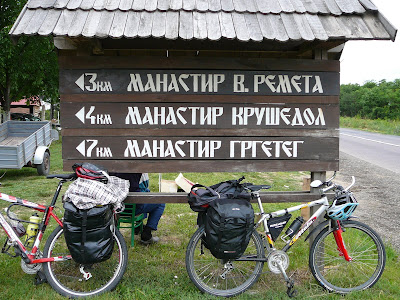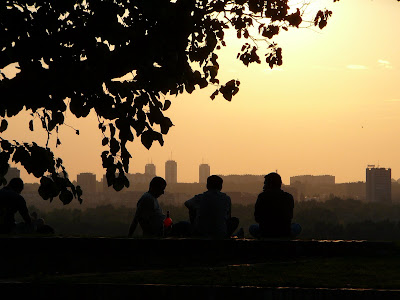Back on the road again, we were about 9km out of Braşov when we came across a "no bikes or horses-and-carts" road sign with no alternative route in sight. We felt more comfortable when we saw another cyclist riding directly past a police car that was stopped to book speeding motorists. The horses and carts didn't seem to heed the sign either.
 Horses and cart on "no horses and carts road"
Horses and cart on "no horses and carts road" 
Happily, we found a campground for the night in Bran. Roger made friends with a fellow camper who explained how he was more comfortable in nudist campgrounds and paraded around in stringy speedos until nightfall.

The next day we took the scenic forest road to Fagaraş, ignoring the "no bikes" sign again. It was on the 14 km stretch to Fagaraş that we experienced one of the only tailwinds so far, making the ride almost effortless, with a fierce storm building behind us over the Carparthian Mountains.
 Iacobeni village from the church tower
Iacobeni village from the church towerWe were fortunate to be travelling through Romania with two good maps. One was a German cycling map given to us by Darinka in Croatia (thanks!). This showed lots of good routes through the country and we learnt that deviating from them led to either really slow dirt roads covered in rocks or to busy highways with lots of trucks. The other map was a Romanian 1:600000 road map. Pink roads on this map were motorways; brown were busy highways; yellow were main routes that were usually some form of asphalt but sometimes dirt; and the majority of the map was covered in white roads which were suitable only for horses and carts, not for bikes. So we tried to stick to yellow where possible.

On to the touristy town of Sighişoara where we stayed with a folk musician within the old town centre, close to this ornate citadel:
As we ventured through the Hungarian enclave in northern Transylvania the street signs were in both Romanian and Hungarian. The largest minority group in Europe, the Romanian Hungarians, number 1.8 million. The region was part of Hungary for 1000 years but was given to Romania as a gift for helping out the Allies in WWI. So even though it's been Romanian territory for 90 years there are villages where no Romanian is spoken, or even understood! Entering one of these small towns, Rugonfalva, we found we had no common language with most of the population - the most we could understand was a smattering of German! The locals at the pub found us a room with the chef, and we communicated in stilted Romanian.
Stork nest and church, Rugonfalva




 Turnu-Severin tower
Turnu-Severin tower  Roger encounters some roadwork
Roger encounters some roadwork Sibiu town wall
Sibiu town wall Eyelid windows
Eyelid windows
 Orthodox Frescos
Orthodox Frescos




















